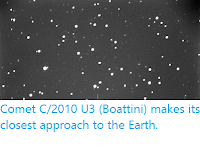Asteroid 2016 XO23 passed by the Earth at a distance of about 14 524 000
km (37.8 times the average distance between the Earth and the Moon, or 9.71% of the distance between the Earth and the Sun),slightly after 12.50 pm
GMT on Sunday 26 January 2020. There was no danger of
the asteroid hitting us, though were it to do so it would have
presented a considerable threat. 2016 XO23 has an estimated
equivalent
diameter of 130-410 m (i.e. it is estimated that a spherical object with
the same volume would be 130-410 m in diameter), and an object of this
size would be predicted to be capable of passing through the Earth's
atmosphere relatively intact, impacting the ground directly with an
explosion that would be 1850-175 000 times as powerful as the
Hiroshima
bomb. Such an impact would result in an impact crater 2-7 km in
diameter
and devastation on a global scale, as well as climatic effects that
would last decades or even centuries.
The calculated orbit of 2016 XO23. Minor Planet Center.
2016 XO23 was discovered on 8 December 2016 by the
University of Arizona's Mt. Lemmon Survey at the Steward Observatory on Mount
Lemmon in the Catalina Mountains north of Tucson. The designation 2016 XO23
implies that the asteroid was the 566th object (asteroid O23 -
in numbering asteroids the letters A-Y, excluding I, are assigned
numbers from 1 to 24, with a number added to the end each time the
alphabet is ended, so that A = 1, A1 = 25, A2 = 49, etc., which means that 023 = (24 x 23) + 14 = 122) discovered in the first half of December 2016 (period 2016 X).
2016 XO23 has a 1113 day (3.05 year) orbital period, with an elliptical orbit tilted at
an angle of 4.36° to the plain of the Solar System which takes in to
0.80 AU from the Sun (80% of the distance at which the Earth orbits the
Sun) and out to 3.40 AU (340% of the distance at which the Earth orbits the sun and more than twice as far from the Sun as the planet Mars). This means that close
encounters between the asteroid and Earth are fairly common, with the
last thought to have happened in January 2017 and the next predicted
in March 2023. It is therefore classed as
an Apollo Group Asteroid (an asteroid that is on average further from the Sun
than the Earth, but which does get closer). As
an asteroid probably larger than 150 m in diameter that occasionally
comes within 0.05 AU of the Earth, 2016 XO23 is also classified
as a Potentially Hazardous Asteroid.
2016 XO23 also
has occasional close encounters with the planets Venus, which it last
came close to in December 2007 and is next predicted to
pass in August 2056, Mars, which it is predicted to pass in May 2062, and Jupiter, which it last came close to in September 1951 and is expected to pass again in January 2046. Asteroids
which make close passes to multiple planets are considered to be in
unstable orbits, and are often eventually knocked out of these orbits by
these encounters, either being knocked onto a new, more stable orbit,
dropped into the Sun, knocked out of the Solar System or occasionally
colliding with a planet.
See also...
Follow Sciency Thoughts on Facebook.







